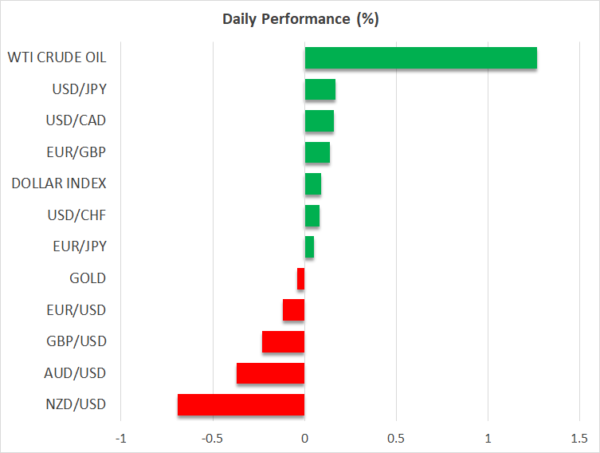- Economic slowdown concerns hit stocks, oil gets demolished
- Commodity currencies struggle too, dollar and yen shine
- But the panic could fade soon, as stimulus hopes return
Pandemic blues hit markets
Worries that the rampaging Delta variant will hamstring the global recovery took a bite out of riskier assets on Monday. Markets seem to be coming to the realization that the vaccines won’t be enough to completely obliterate the virus, as the mutations keep getting more resilient.
Many governments are also struggling with vaccine hesitancy, which is blocking the path towards herd immunity. Meanwhile, developing nations simply don’t have enough vaccines to escape the lockdown spiral. Add everything up and it looks like the pandemic might stick around for a long time.
All this translated into another session characterized by fear. Stocks on Wall Street fell sharply, but in classic pandemic fashion, tech and growth names didn’t get hit as hard as value and reopening plays. Whenever investors are worried about growth, they seek shelter in tech companies that can prosper even under lockdown conditions, and whose extreme valuations become more reasonable as bond yields fall.
But the real fireworks were in oil prices, which fell almost 7% as traders took profits or covered their bullish bets, decimating the oil-sensitive Canadian dollar. The demand outlook is turning darker just as OPEC locked in steady supply increases, raising doubts about how long the oil market will remain undersupplied.
Can it last?
The rotation to safety was also clear in defensive plays like the US dollar and the yen, which capitalized mainly on the havoc in commodity currencies. Even gold managed a comeback, defying the mighty dollar and instead drawing power from the collapse in real US yields, which are now back within breathing distance of their record lows.
The burning question is how much further this correction has to go. Most assets have stabilized today and a sense of calm has returned, but it’s difficult to say the storm has truly passed. Emotions are the name of the game right now, and those can swing quickly.
The silver lining is that if economic growth is hit as hard as markets currently suggest, the major central banks will likely push back their normalization plans and governments could keep spending heavily for longer. As this crisis has shown, extravagant government spending and cheap money policies are an incredibly powerful elixir for financial markets that can overpower virus fears.
Therefore, the real question is how much worse things have to get before the Fed hits the panic button, calming markets down.
Aussie and kiwi extend losses
The only currencies that haven’t stabilized today are the Australian and New Zealand dollars, as well as the British pound. The aussie has been caught in the crossfire of falling commodity prices, an extension of the lockdowns across Australia, and whispers that the RBA could soon put its tapering plans into reverse.
Meanwhile, the kiwi sliced through some key support levels, even as markets continue to price in even chances for an RBNZ rate increase next month. The island remains virtually virus-free and recent data suggest the economy is booming, but currency markets seem to be saying that raising rates in an environment of slowing global growth will be tricky.
Finally, the British pound remains under pressure as well, unable to capitalize on the newfound calm in stock markets. Britain is grappling with another outbreak, and while hospitalizations are still low thanks to the vaccines, health officials suggest the situation will get worse before it gets better.
Another element tormenting the pound is the dovish tone of the Bank of England’s latest addition, Catherine Mann, who made it clear in her first public appearance yesterday that she won’t get behind an early withdrawal of stimulus.
As for today, the earnings season gets rolling with Netflix and United Airlines.














